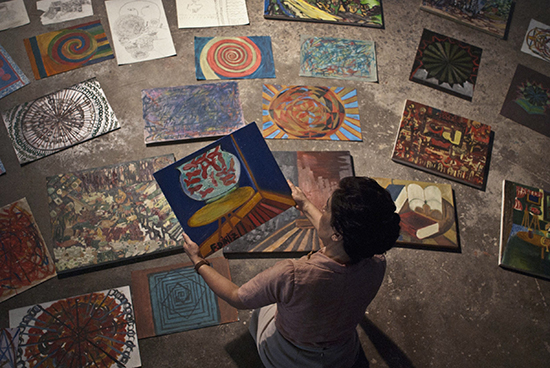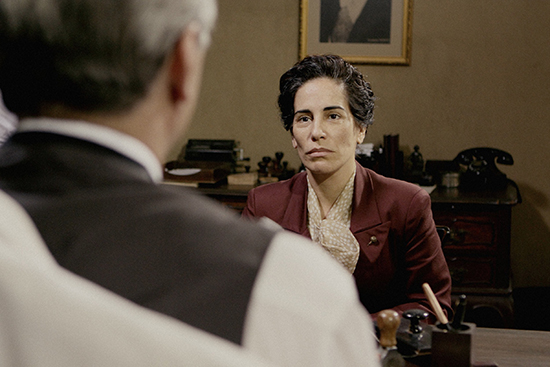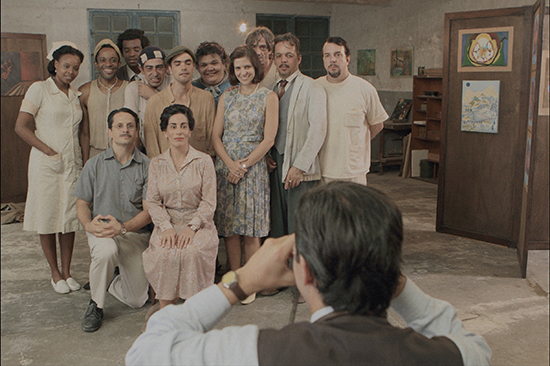Madness, Compassion, Art
Nise: The Heart of Madness, directed by Roberto Berliner, tells the story of Dr. Nise da Silveira (Gloria Pires), a Brazilian psychiatrist who pioneered the treatment of schizophrenic patients with kindness and art therapy, resulting in both medical and artistic breakthroughs. Though a conventional film, Nise is fascinating and poignant. Not only is da Silveira a heroine well worth rooting for, but these outsider artists and their creative processes are portrayed with great respect. (And, unlike some depictions of psychiatric patients, the actors playing Nise’s charges seem believably afflicted.)
The film opens in 1940s Rio de Janeiro. A small woman knocks repeatedly at a metal door unless it finally opens. This is a fitting introduction to da Silveira, who has come to work at the National Psychiatric Center, the only female doctor on the staff. In a meeting, lobotomy is discussed dispassionately as miracle cure, while a demonstration of a patient forced to undergo electroconvulsive treatment is looked upon equally casually by everyone but da Silveira, who can barely contain her horror. Refusing to take part in these conventional methods, she is relegated to supervising the Occupational Therapy Sector, previously run by a nurse and an orderly.
Despite the fact that several of the hospital’s inmates have violent tendencies, Nise is compassionate and patient, unlike most of the staff, who treat them with cruelty and ridicule. Under her care, the previously filthy OC wing is cleaned and a group patients—most of whom are deeply entrenched in their own worlds–are led in. Rather than abuse those who act out, she observes and lets them be, repeatedly admonishing her hot-tempered orderly to do the same.
When sympathetic, art-loving staffer Amir (Felipe Rocha) suggests an art studio, da Silveiro agrees, noticing one patient who has been drawing on the wall with his own feces. (Berliner does not spare us off-putting behavior, all the better to appreciate da Silveira’s near-saintly forbearance.) It’s a long, slow process before many of the patients take to this new outlet. For them, the creative process is clearly very intense; Berliner shows how these poor souls, unable to express themselves conventionally, wrench out their thoughts and emotions onto canvas or into sculpture, through careful brushstrokes or energetic clay molding. Meanwhile, Nise’s husband has given her a book by Karl Jung and she begins applying the latter’s ideas about mysticism and the unconscious to interpretations of her charges’ creations. She writes to Jung about her experiment, enclosing photos of the paintings. Per the celebrated psychoanalyst, Nise uncovers her artists’ pasts and we learn what they are expressing in their artwork.
When the OCT puts on a show, major art critic Mario Pedrosa shows up, amazed by the work on display. He is convinced that the rest of the world needs to see this art. The hospital’s other doctors, however, are not as impressed. (Though the patients’ behavior has improved, they haven’t formally been “cured”). With every step forward (an encouraging Jung writes back), there’s a setback, such as the hospital’s callous response to the dogs Nise has brought to the center for patients to care for. Undeterred, the tenacious Nise is unwavering in her belief in her methods and support of the patients. Gradually, released from their minds, the previously silent artists begin to speak. One of them, formerly considered incurable, improves enough to go home.
Championed by Pedrosa, the art is exhibited publicly in a show called Don’t Fear the Unconscious. Some of the artists under Nise’s care (including Carlos Pertuis and Emygdio de Barros) would go on to become highly regarded artists in Brazil.
Nise: The Heart of Madness ends with footage of the actual patient-artists portrayed, and a video snippet of an interview with an elderly and spritely da Silveira. Though it is somewhat predictable in its good vs bad doctor dynamic and dialogue that is a tad obvious (“My instrument is a brush; yours is an icepick!”), this compassionate movie’s strengths outweigh any deficiencies.
Nise: The Heart of Madness opens on Friday, April 28, at Village East Cinema, 181-189 Second Ave., Manhattan.
—Marina Zogbi




